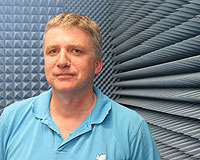| Posted: May 24, 2010 |
Ultra-secure quantum communications |
|
(Nanowerk News) The risk of sensitive information falling into the wrong hands could be eliminated by a new quantum communication process that delivers unprecedented security.
|
|
UNSW telecommunications researcher Robert Malaney has developed the process, called "unconditional location verification", which ensures that even if an encryption password has fallen into the wrong hands, a secure message can only be seen by a recipient at an agreed geographic point.
|
|
Associate Professor Malaney, of the University of New South Wales (UNSW) School of Electrical Engineering and Telecommunications, said quantum communications already allow unbreakable encryption but security can now be further enhanced using unconditional location verification.
|
 |
| Rob Malaney
|
|
"This takes communications security to a level that hasn't previously been available," he said.
|
|
"With this process you can send data to a person at a particular location. If they are not at that location the process would detect that and you can stop the communication.
|
|
"This is a new application that you can deploy on current and emerging quantum networks. It opens up a range of new information security applications for both fibre and wireless communication networks.
|
|
"There would be many industries and organisations, banks for example, that would be interested in delivering information content in the sure knowledge a recipient is at an agreed-upon location."
|
|
The concept, which also has potential applications in the intelligence community, e-commerce and digital content distribution, is reported in the April edition of the American Physical Society journal Physical Review A.
|
|
The system works by sending paired "qubits" – particles, such as photons, which have been manipulated to contain specific quantum information – over a fibre optic or wireless network to a recipient. The recipient must send a return message, using information from the decoded qubits, to a number of reference points to open up a secure channel. Because quantum networks operate at the speed of light and quantum information cannot be copied, the time to return the message can be accurately measured, ensuring that it has come from only one possible place.
|

